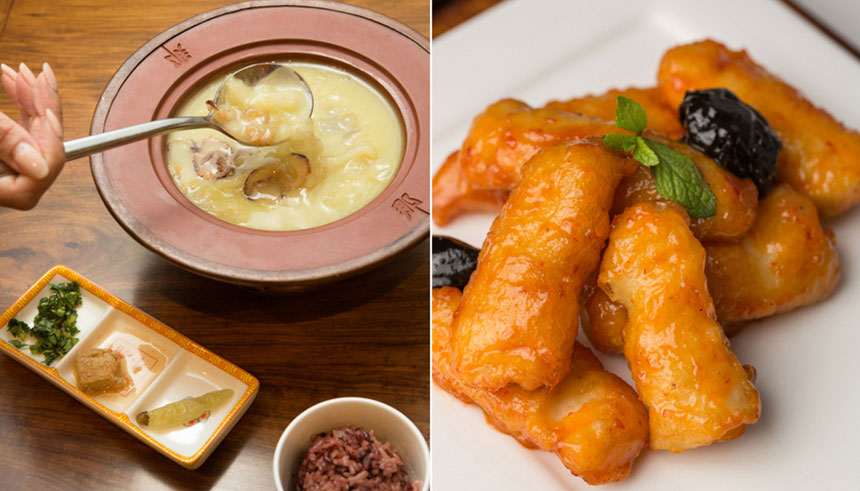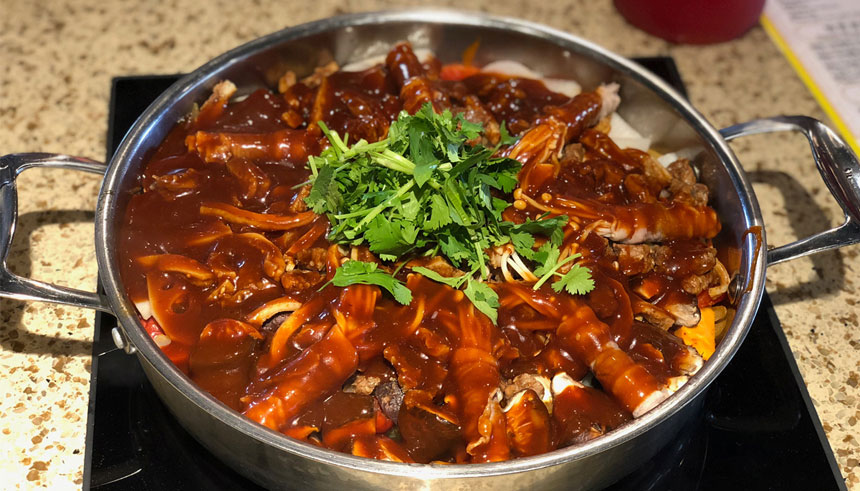East West Lifestyle
Hang & Eat: New Asian Food Trend is to Eat like a Chinese Emperor
By Kristie Hang

Our new food blogger Kristie Hang shows you how to eat like royalty.
Los Angeles has always been at the forefront of what’s hip, especially when it comes to food. With the San Gabriel Valley being home to such a large enclave of ethnic Chinese outside of China, it comes as no surprise that Los Angeles has frequently been the testing ground for the latest and most unique foods straight from Asia. In the United States, Chinese food typically has a reputation for being an unhealthy, cheap, MSG-laden cuisine, but there’s a new food trend that is changing that perception: Imperial Chinese Cuisine.
Imperial Chinese Cuisine (gong ting cai) is the most recent regional cuisine that has made its way to the U.S. It is a style of cooking that was made primarily for the Emperor and his royal family. This style of food uses skillful cooking methods and careful selection of ingredients, which are often rare, pricey, complex in preparation, and very visually ornate. This cuisine itself places an emphasis on the experience, service, and presentation (elements typically not associated with Westernized Chinese food, at least). For those who want to try something new, here are two restaurants where you can eat like an emperor for a day!
Bistro Na’s:
Bistro Na’s, which opened in Temple City in late 2016, was the first restaurant to serve China’s Imperial Cuisine in the United States. Bistro Na’s is the U.S. branch of the Beijing-based Na Jia Xiao Guan. It is one of few Imperial Chinese Cuisine restaurants in the U.S., which means it serves food that was originally designed for royalty and uses many recipes that have been passed down through the generations from chefs who worked in the Imperial kitchen. The restaurant mimics a traditional Chinese courtyard from the Qing Dynasty. Diners feel like royalty once they walk into the dining room, with its carved wood paneling, jade, and traditional musical instruments displayed like an art exhibit. Even the physical menu is luxurious: It’s bound with a soft cloth cover and is known as "the heaven menu."
“Many of the recipes used at the restaurant were passed down through my partner’s ancestors,” says Bistro Na’s co-owner, XianYi Kong. “Bistro Na’s is a testament that Chinese food can also be as high-end as Western cuisine. We really wanted to show a different aspect of Chinese cuisine that you don’t often see in the U.S. My partner Jing Lin Na’s family lineage can be traced back to one of the Eight Imperial Banners of the Qing dynasty. The Eight Banners were considered the most trusted nobles of the royal family and lived around the Imperial Palace.”
Imperial cuisine is more elevated than the run-of-the-mill Chinese food most people are familiar with. Even the vegetable fried rice at Bistro Na’s is more extravagant. They use five oats rice, cranberries, corn, broccoli, mushrooms, and egg to make a mound of rice look like a rainbow. Unlike many Chinese restaurants, Bistro Na’s has an open kitchen. It is helmed by executive chef, Yong Tian, who spent over a decade working for a number of top hotels and five-star restaurants in Beijing. He also served as the executive chef for the 2008 Beijing Olympics and 2010 16th Asian Games, prior to joining Bistro Na’s.

So what kinds of dishes are considered Imperial cuisine? For starters, scallops were considered jewels from the sea that were offered to royals back in the day. In modern times, Bistro Na’s scallops are served with a sweet Beijing sauce. Bistro Na's Spicy Chicken is a classic. Plating is also serious business. Colors and presentation are a big part of Imperial Court Cuisine. As for desserts, Bistro Na’s sweet treats are also made from royal favorites, such as red bean and sweet rice rolls. One of the most celebrated dishes at Bistro Na’s is the Emperor’s Jar soup. According to a legend, when Imperial soldiers returned victoriously from battle, the Emperor would present them with lavish gifts for their efforts. With the precious ingredients that were bestowed upon them, they created a stew called the Emperor's Jar. Bistro Na’s modern-day version of the dish is presented in a red clay rim bowl. The soup is extremely flavorful and made from high-quality chicken stock that has been simmering for 12-plus hours. The beef tendon inside absorbs the chicken stock, which infuses the tendon with richness. There are also condiments to add for additional flavors such as pickled chili peppers, cilantro, and fermented tofu.
The most popular menu items at Bistro Na’s include: Crispy Shrimp, Smoked Pork Rib, Stewed Pork Belly, their amazing Green Onion Pancakes, and Emperor’s Jar. Certain dishes are inspired by Qing Royal courts, like the Smoked Pork Ribs. The Baked Golden Dungeness Crab has as many as eight different preparations, including stir-fried with ginger and scallion, stir-fried with crispy garlic and chili, baked with black pepper with butter, and seasoned with salt and pepper. Bistro Na’s also just released a new menu where you’ll find healthier dishes, such as okra topped with fried ginger slices and sweet red peppers.
Simmer Huang:
Simmer Huang is another one of the few Imperial Chinese Cuisine restaurants in the United States. CEO Gen Huang’s ancestors served as chefs to the Chinese royal family. The recipe Simmer Huang uses for their famous “Three Sauce” simmer pot supposedly goes back more than a century.

“Foodies are elevating the game. Americans are no longer content with the typical Americanized Chinese food anymore. They want to taste what real Chinese food is supposed to taste like, unaltered,” says Simmer Huang owner, Gavin Zhao.
Although Simmer Huang pots look similar to shabu shabu or hot pot, it is more akin to a crockpot. Simmer Huang’s “simmer pots,” as they call them, cook and steam the diner’s choice of proteins, along with herbs and juices from 10 different types of vegetables— without the addition of water. The meal is cooked at the table, where your server tops it off with rice wine, sesame oil and soy sauce. The result is a pot full of delicious ingredients cooking in their own juices. In the U.S., diners are not used to a server being at the table and being an integral part of the dining process, especially when eating Chinese food. At Simmer Huang, the diner doesn’t lift a finger. The server does it all.
Your server layers the pot, alternating between proteins and vegetables before it is covered and simmered for 15 minutes. When the pot is cooked halfway, your server will mix and add in Simmer Huang’s “secret recipe sauce,” made with 30 types of herbs. After spreading the sauce evenly through the pot, your server covers it again and lets it simmer for an additional five to 10 minutes. The meal ends with a tableside performance, with the master noodle-maker dancing while spinning and stretching out long, fresh noodles into the pot. The entire dining experience can take at least an hour and a half, so make sure to budget more time than your typical Chinese meal. It is quite literally dinner and a show, and is sure to impress your friends.
Both Bistro Na’s and Simmer Huang are just two additions to a growing list of established Chinese names offering higher-end, authentic regional cuisines. The brands are entering the U.S. market at a time when foodies are more adventurous with their palates and looking for more unique foods and dishes to try.
Bistro Na’s: 9055 Las Tunas Drive, Suite 105, Temple City, CA 91780, (626) 286-1999
Simmer Huang: 5728 Rosemead Blvd, Suite 107, Temple City, CA 91780, (626) 656-6333.
Hang & Eat with our food blogger Kristie Hang as she explores the latest East West food trends

